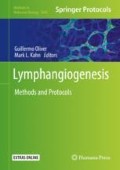Abstract
Lymphatic contractile dysfunction has been identified in several diseases, including lymphedema, yet a detailed molecular understanding of lymphatic muscle physiology has remained elusive. With the advent of genetic methods to manipulate gene expression in mice, a set of new tools became available for the investigation and visualization of the lymphatic vasculature. To gain insight into the molecular regulators of lymphatic contractile function, regulated primarily by the muscle cell layer encircling lymphatic collecting vessels, ex vivo approaches to allow control of hydrostatic and oncotic pressures and flow have been invaluable, complementing in vivo methods. While the original ex vivo techniques were developed for lymphatic vessels from large animals, and later adapted to rat vessels, here we describe modifications that enable the study of isolated, pressurized murine lymphatic collecting vessels. These methods, used in combination with transgenic mice, can be a powerful tool to investigate the molecular and cellular mechanisms of lymphatic function.
Access this chapter
Tax calculation will be finalised at checkout
Purchases are for personal use only
References
Bayliss WM (1902) On the local reactions of the arterial wall to changes of internal pressure. J Physiol 28:220–231
Duling BR, Gore RW, Dacey RG Jr, Damon DN (1981) Methods for isolation, cannulation, and in vitro study of single microvessels. Am J Physiol Heart Circ Physiol 241:H108–H116
Osol G, Halpern W (1985) Myogenic properties of cerebral blood vessels from normotensive and hypertensive rats. Am J Physiol 249:H914–H921
Burg MB, Orloff J (1973) Perfusion of isolated renal tubules. In: Orloff J, Berliner RW (eds) Handbook of physiology, renal physiology. American Physiological Society, Washington, DC, pp 145–159
Gashev AA, Davis MJ, Zawieja DC (2002) Inhibition of the active lymph pump by flow in rat mesenteric lymphatics and thoracic duct. J Physiol 450:1023–1037
Mizuno R, Dornyei G, Koller A, Kaley G (1997) Myogenic responses of isolated lymphatics: modulation by endothelium. Microcirculation 4:413–420
Maejima D, Kawai Y, Ajima K, Ohhashi T (2011) Platelet-derived growth factor (PDGF)-BB produces no-mediated relaxation and PDGF receptor b-dependent tonic contraction in murine iliac lymph vessels. Microcirculation 18:474–486
Mizuno R, Ono N, Ohhashi T (2001) Parathyroid hormone-related protein-(1-34) inhibits intrinsic pump activity of isolated murine lymph vessels. Am J Physiol Heart Circ Physiol 281:H60–H66
Scallan JP, Davis MJ (2013) Genetic removal of basal nitric oxide enhances contractile activity in isolated murine collecting lymphatic vessels. J Physiol 591:2139–2156
Zawieja SD, Castorena-Gonzalez JA, Scallan J, Davis MJ (2018) Differences in L-type calcium channel activity partially underlie the regional dichotomy in pumping behavior by murine peripheral and visceral lymphatic vessels. Am J Physiol Heart Circ Physiol 314(5):H991–H1010
Davis MJ, Kuo L, Chilian WM, Muller JM (1995) Isolated, perfused microvessels. In: Barker JH, Anderson GL, Menger MD (eds) Clinically applied microcirculation research. CRC Press, Boca Raton, FL, pp 435–456
Hargens AR, Zweifach BW (1977) Contractile stimuli in collecting lymph vessels. Am J Physiol Heart Circ Physiol 233:H57–H65
Zweifach BW, Lipowsky HH (1984) Pressure-flow relations in blood and lymph microcirculation. In: Renkin EM, Michel CC (eds) Handbook of physiology section 2: the cardiovascular system, vol IV, chp. 7, 297. American Physiological Society, Bethesda, MA, pp 251–307
Zawieja SD, Castorena-Gonzalez JA, Dixon B, Davis MJ (2018) Experimental models used to assess lymphatic contractile function. Lymphat Res Biol 15(4):331–342
Wolinsky H, Glagov S (1964) Structural basis for the static mechanical properties of the aortic media. Circ Res XIV:400–413
Scallan JP, Wolpers JH, Muthuchamy M, Zawieja DC, Gashev AA, Davis MJ (2012) Independent and interactive effects of preload and afterload on the lymphatic pump. Am J Physiol Heart Circ Physiol 303:H809–H824
Lapinski PE, Lubeck BA, Chen D, Doosti A, Zawieja SD, Davis MJ, King PD (2017) RASA1 regulates the function of lymphatic vessel valves in mice. J Clin Invest 127:2569–2585
Davis MJ, Lane MM, Davis AM, Durtschi D, Zawieja DC, Muthuchamy M, Gashev AA (2008) Modulation of lymphatic muscle contractility by the neuropeptide substance P. Am J Physiol Heart Circ Physiol 295:H587–H597
Hamill OP, Marty A, Neher E, Sigworth FJ (1981) Improved patch-clamp techniques for high-resolution current recording from cells and cell-free membrane patches. Pflugers Arch 391:85–100
Davis MJ, Scallan JP, Wolpers JH, Muthuchamy M, Gashev AA, Zawieja DC (2012) Intrinsic increase in lymphatic muscle contractility in response to elevated afterload. Am J Physiol Heart Circ Physiol 303:H795–H808
Zhang R, Gashev AA, Zawieja DC, Lane MM, Davis MJ (2007) Length-dependence of lymphatic phasic contractile activity under isometric and isobaric conditions. Microcirculation 14:613–625
Davis MJ (2005) An improved, computer-based method to automatically track internal and external diameter of isolated microvessels. Microcirculation 12:361–372
Acknowledgments
This work was funded by grants from the National Institutes of Health R01 HL-120867, R01 HL-122608, R01 HL-122578 to M.J.D., and R00 HL-124142 to J.P.S.
Author information
Authors and Affiliations
Corresponding author
Editor information
Editors and Affiliations
Rights and permissions
Copyright information
© 2018 Springer Science+Business Media, LLC, part of Springer Nature
About this protocol
Cite this protocol
Castorena-Gonzalez, J.A., Scallan, J.P., Davis, M.J. (2018). Methods for Assessing the Contractile Function of Mouse Lymphatic Vessels Ex Vivo. In: Oliver, G., Kahn, M. (eds) Lymphangiogenesis. Methods in Molecular Biology, vol 1846. Humana Press, New York, NY. https://doi.org/10.1007/978-1-4939-8712-2_15
Download citation
DOI: https://doi.org/10.1007/978-1-4939-8712-2_15
Published:
Publisher Name: Humana Press, New York, NY
Print ISBN: 978-1-4939-8711-5
Online ISBN: 978-1-4939-8712-2
eBook Packages: Springer Protocols

